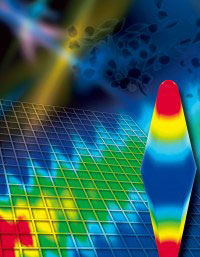| Posted: August 17, 2009 |
New understanding how nanoparticles lose energy |
|
(Nanowerk News) By studying gold nanoparticles of highly uniform size and shape, scientists now understand how they lose energy, a key step towards producing nanoscale detectors for weighing any single atom.
|
|
Such ultra-sensitive measurements could ultimately be used in medical research and diagnostics, enabling the detection of minuscule disease-causing agents such as viruses and prions at the single molecule level.
|
|
Nanoscale devices capable of measuring the mass of a single biological molecule and the heavier elements have already been developed. Yet, significant advances are still required to reach the ultimate goal of weighing the lightest elements such as hydrogen.
|
 |
| Microscope image of vibrating nano-particles.
|
|
Researchers have been drawn to nanosized materials because the smaller the components of a detection device, the more sensitive it is.
|
|
A team from the University of Melbourne, Argonne’s Center for Nanoscale Materials in Illinois and the University of Chicago has synthesised and studied tiny gold rods with a width 5000 times smaller than the thickness of a human hair.
|
|
Professor John Sader from the Department of Mathematics and Statistics, University of Melbourne, says that in the same way a classroom ruler decreases its frequency of vibration when an eraser is attached, nanomechanical mass sensors work by measuring their change in vibration frequency as mass is added.
|
|
The sensitivity of such nanomechanical devices is intimately connected to how much energy they displace. So researchers need to understand how damping (loss of energy) is transferred both to the fluid surroundings and within the nanostructures.
|
|
With the lower the damping, the purer the mechanical resonance and the higher the sensitivity.
|
|
It has not previously been possible to determine the rate at which vibrations in metal nanoparticle systems are damped, because of significant variations in the dimensions of the particles that have been studied – which masks the vibrations.
|
|
|
|
However, by studying a system of bipyramid-shaped gold nanoparticles of highly uniform size and shape, the researchers overcame this limitation. |
|
“Previous measurements of nanomechanical damping have primarily focused on devices where only one or two dimensions are nanoscale, such as long nanowires. Our measurements and calculations provide insight into how energy is dissipated in devices that are truly nanoscale in all three dimensions,” says Professor Sader.
|
|
By illuminating these bipyramidal nanoparticle systems with an ultra-fast laser pulse they were set vibrating mechanically at microwave frequencies. The vibrations were long-lived and for the first time damping in these nanoparticle systems could be interrogated and characterised.
|
|
Moreover, the researchers separated out the portion of damping that is due to the material itself and that which is due to surrounding liquid, for which they developed a parameter-free theoretical model that quantitatively explains this fluid damping.
|
|
The study will be published in an upcoming issue of Nature Nanotechnology.
|

